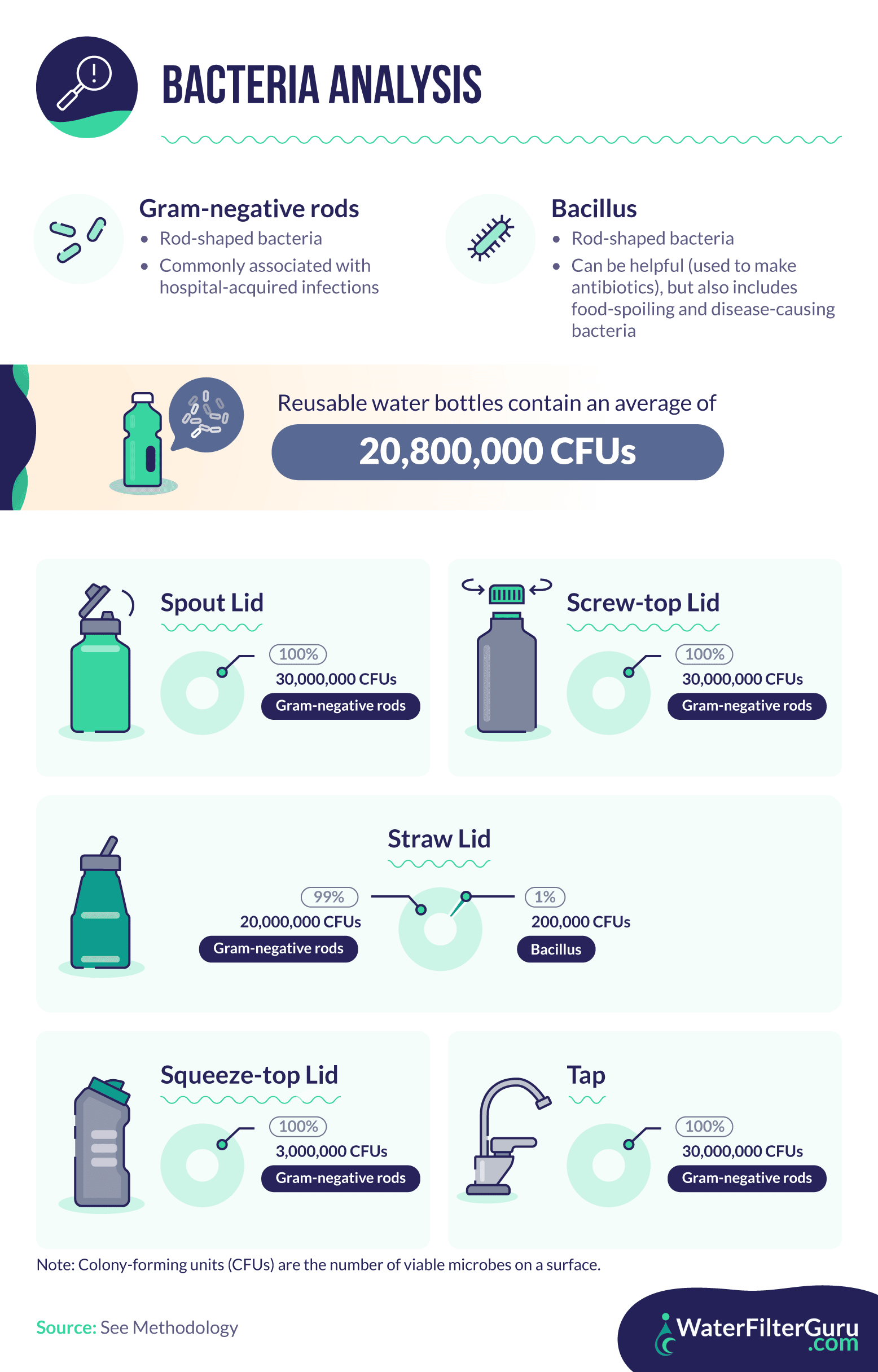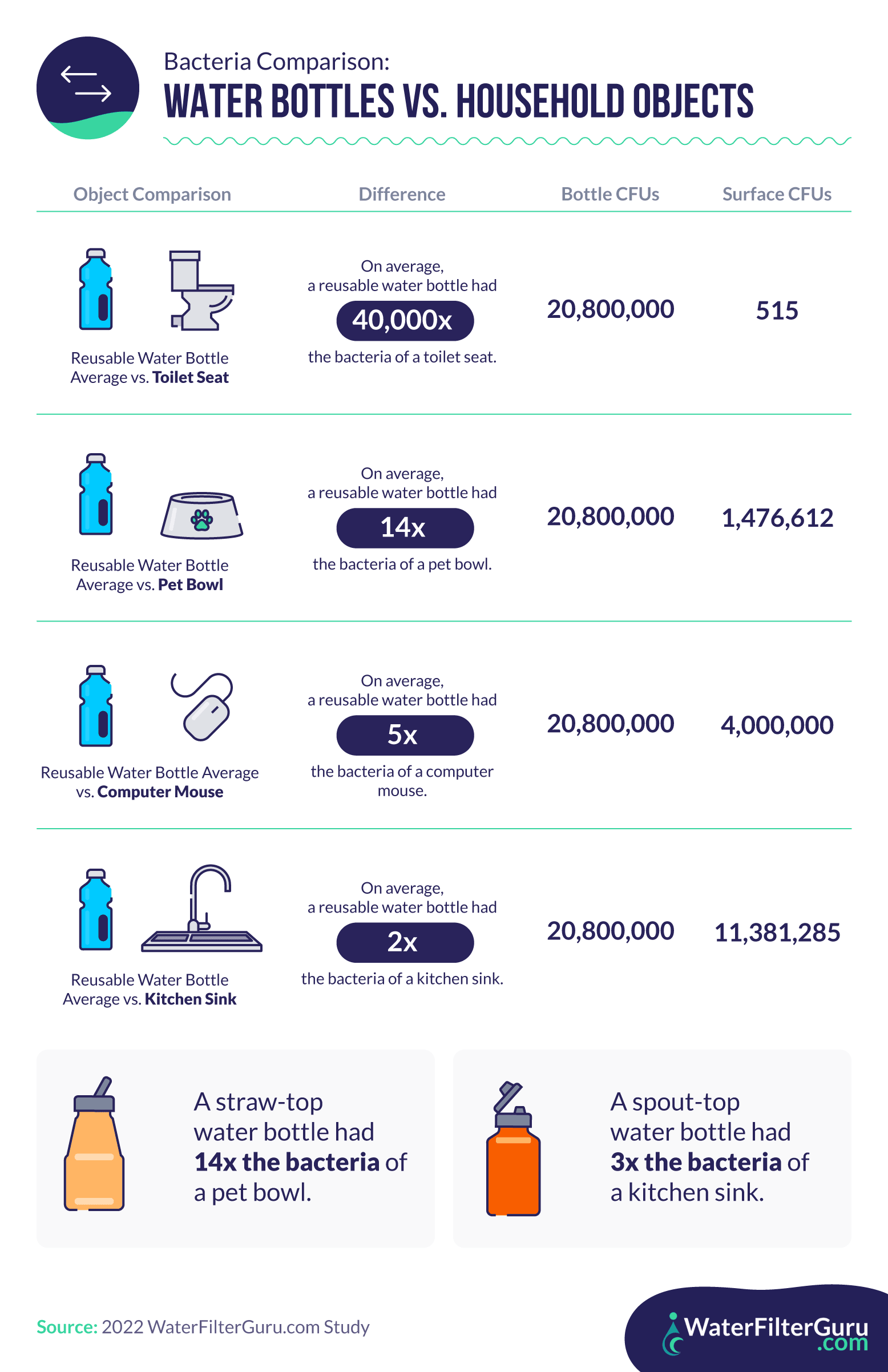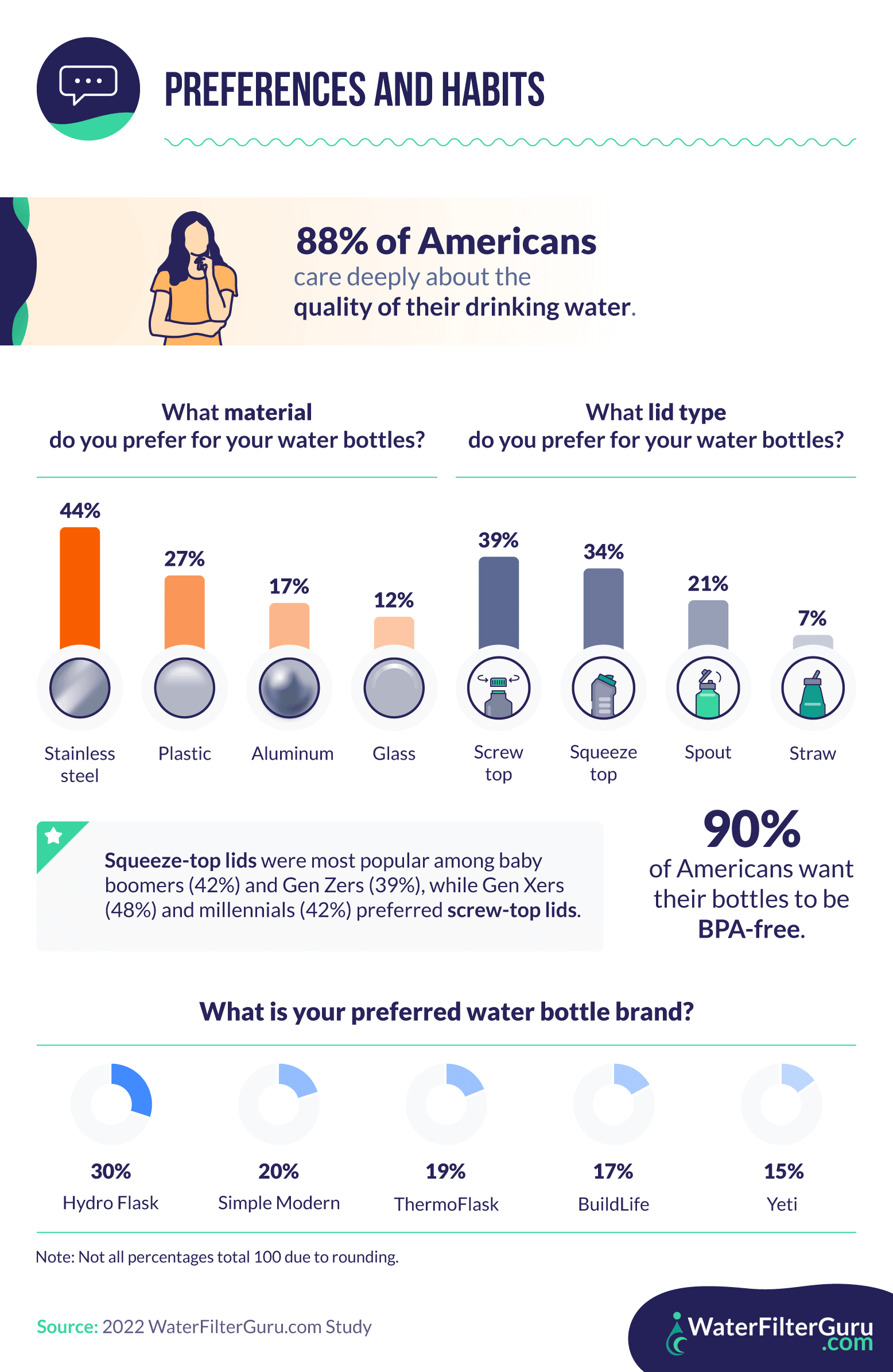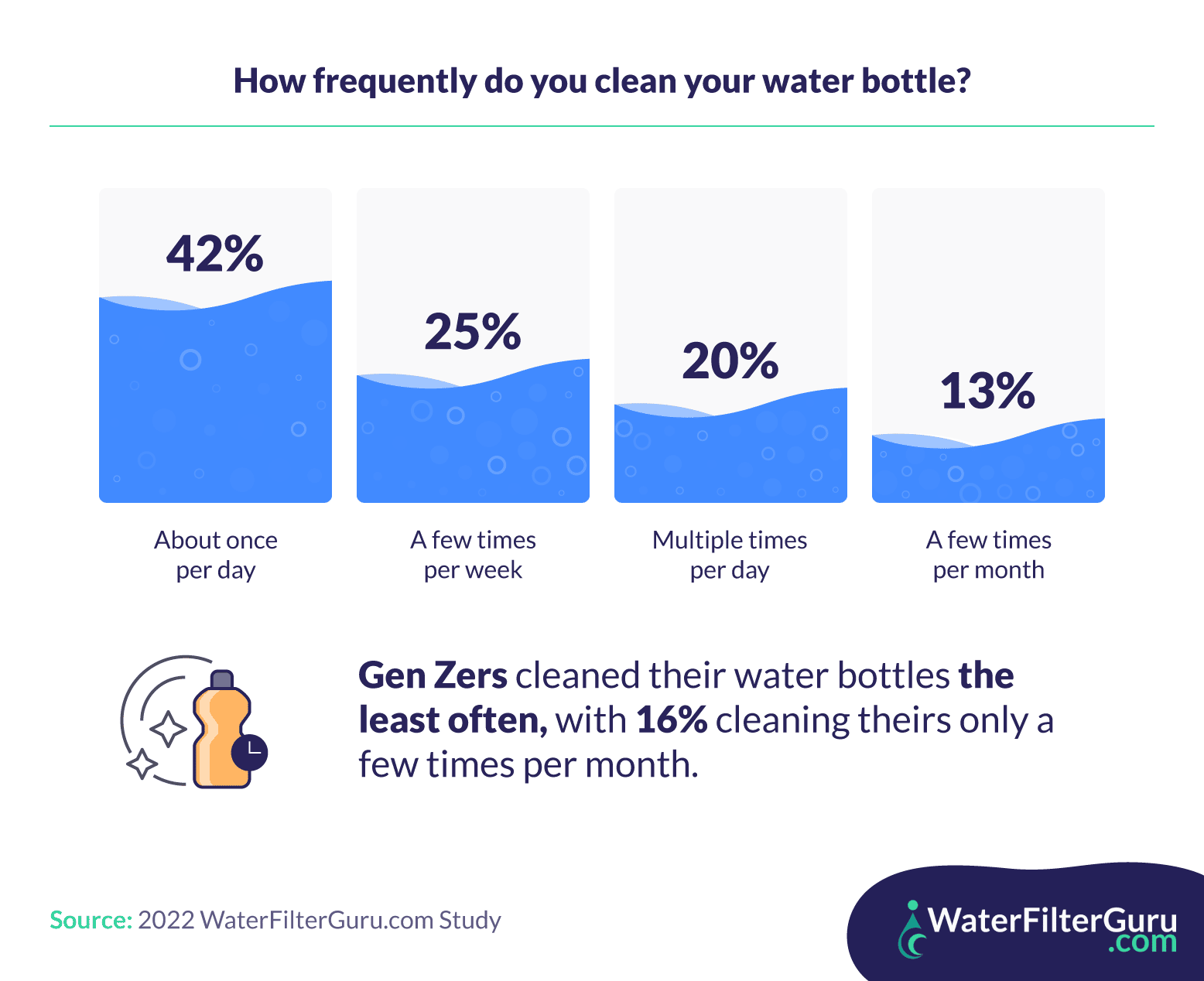Swabbing Water Bottles: How Clean Is the Water You Drink?

What else are you carrying around all day?
The world is a germy place to live, and there are all sorts of viruses and bacteria on the surfaces we encounter every day. They’re not all harmful, but some germs can make you pretty sick.
For this bacteria study, WaterFilterGuru.com investigated an item many people carry around and drink from all day long — the reusable water bottle. Have you ever thought about what type of bacteria might live in your water bottle? Keep reading to discover what you could be ingesting with every sip as you hydrate and stay healthy (supposedly).
📌 Key Takeaways
- Spout-top and screw-top lids contained the most bacteria of all the water bottles, with 30 million CFUs each.
- A squeeze-top water bottle had 6,000x the bacteria of a toilet seat.
- Nearly 15% of Americans clean their water bottles only a few times per month.
How dirty is your water bottle?
When people mention bacteria, you probably think of getting sick, and no one wants germs in their drinking water. Let’s see how much and what bacteria were found by a professional lab in the water bottle samples we sent them.

Are you surprised by how germy reusable water bottles and sink taps are? You’re likely thinking about sanitizing these items ASAP.
For this study, we swabbed these items three times each, and researchers found two types of bacteria present: gram-negative rods and bacillus. Gram-negative bacteria can cause infections that are becoming increasingly resistant to antibiotics, while certain types of bacillus can lead to gastrointestinal issues.
Colony-forming units (CFUs) estimate how many living microbes are in a sample. By our count, reusable water bottles have an average of 20.8 million CFUs of bacteria. The faucet we tested had 30 million CFUs of gram-negative rods — the same as the water bottles with spouts or screw-top lids. Squeeze-top bottles were the cleanest, having only a tenth of that amount of bacteria (3 million CFUs).
Bacteria are known as biological drinking water contaminants. They’re just one of four types of pollutants that might be present in the water coming out of your taps and into your reusable bottles. Even though U.S. tap water is considered some of the safest in the world, contamination can still occur. A water quality test can help you determine what’s in your water and what you’ll need to do to ensure it’s safe and clean.
Water Bottles vs. Household Objects
After comparing water bottles to sink taps, we wondered how they would fare against other objects in a home. Spoiler alert — they were germier than a toilet seat!

Kitchen sinks are known to be one of the most germ-filled spots in a home, and we found that reusable water bottles were about twice as germy. They were even dirtier than a pet bowl that’s slobbered on every day and a computer mouse’s high-touch surface. More surprisingly, the average reusable water bottle was 40,000 times dirtier than a toilet seat. Knowing all this makes a compelling argument to clean water bottles often and thoroughly.
Are you cleaning your bottle frequently enough?
Moist environments are breeding grounds for germs. That’s why washing a reusable water bottle you drink from every day should be part of your daily routine. What types of water bottles do most Americans prefer to drink from, and how good are their cleaning habits?

Hydro Flask was the most popular brand of water bottle among our respondents, followed by Simple Modern and ThermoFlask. They also most often preferred containers made from stainless steel (44%) and with screw-top lids for leakproof portability (39%). Most Americans care deeply about the quality of their drinking water, so it makes sense that 90% wanted BPA-free bottles. But how well are they keeping their reusable water bottles clean and safe to drink from?

More than 60% of respondents said they clean their water bottles once or more per day, but others weren’t so diligent. One-quarter of Americans wash their water bottles just a few times per week, while over 10% only clean them a few times per month.
The same vessel that brings healthy hydration to your daily routine could make you sick if not cared for properly. If you’ve been feeling unwell, check in with your water bottle cleaning habits to see if bacteria and mold might be the culprit. Experts recommend washing your water bottle once a day and sanitizing it at least once a week, more often if you’ve been sick, drinking while eating, or filling it with something other than water — especially if it has sugar.
You also need to be mindful of the water you’re putting into your reusable bottle. It might look clean, but inadequately treated water or contaminated pipes can decrease the safety of your drinking water. Filtering your water at home is a great way to ensure you’re filling those sanitized bottles with the purest water.
Staying Healthy and Hydrated
Staying hydrated is very important to your health, and everyone deserves fresh drinking water that’s clean and tastes great. Remember that we can’t see the germs living among us. So while your reusable water bottle might not look dirty, it’s essential to wash and sanitize it regularly because it likely is. Even the best washing habits can’t fix the water going into your bottles, so now might be the right time to consider getting your home water tested.
Methodology
WaterFilterGuru.com collected samples from surfaces for the purpose of this study; each surface was swabbed three times, and the CFUs per swab were averaged for each surface type. A lab conducted three-gram and stain culture swab tests across reusable water bottles. It’s possible that we could have gained further insight into CFU levels with a larger sample size of surfaces. The above claims are based on means alone, as no statistical testing was performed, and so, this content is exploratory. Bacteria definitions were sourced from ncbi.nlm.nih.gov and britannica.com.
Additionally, we surveyed 1,000 Americans regarding their water bottle preferences and habits. The mean age of respondents was 40 years old. Among them, 57% were male, and 43% were female. Respondents comprised the following generational breakdown: 21% Gen Z, 29% millennials, 27% Gen X, and 23% baby boomers.
About WaterFilterGuru.com
WaterFilterGuru.com is on a mission to help consumers find information, products, and solutions to address their water quality needs because everyone should have access to such a vital resource.
Fair Use Statement
This content is for educational and informational purposes only. Know someone who drinks from reusable water bottles that would benefit from our findings? You’re permitted to share this article with them for noncommercial purposes only, as long as you provide a link back to this original web page.
